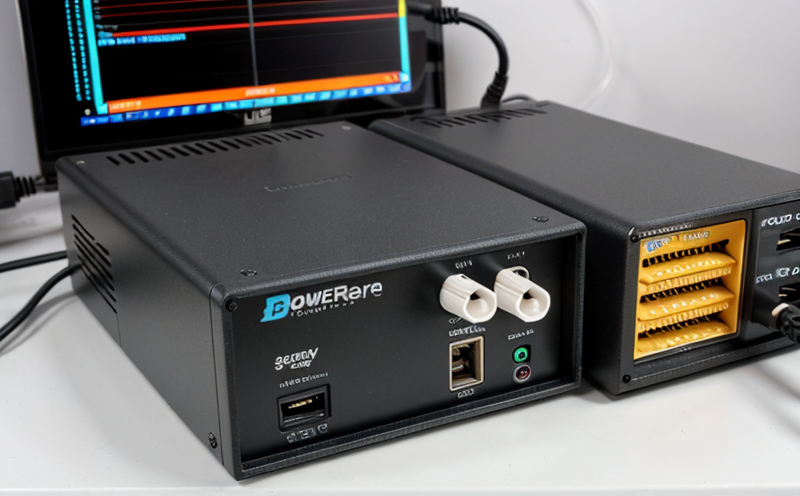EN 61000 EMC Compliance Testing for Switch Mode Power Supplies
The EMC compliance testing of switch mode power supplies (SMPS) is a critical step in ensuring that electronic devices meet the stringent requirements set by international standards such as EN 61000. This standard ensures that electrical and electronic equipment generates minimal electromagnetic interference, which can disrupt the functioning of other devices within its environment.
Switch Mode Power Supplies are widely used in consumer electronics, industrial applications, telecommunications, medical devices, and automotive systems due to their efficiency and ability to provide stable voltage under varying load conditions. However, these benefits come with a downside: they emit significant electromagnetic interference (EMI) which can affect nearby electronic devices.
The EN 61000 family of standards provides comprehensive guidelines for EMC testing, covering a wide range of topics including emission limits, immunity requirements, and the methods used to measure compliance. For switch mode power supplies, EN 61000-4-2 specifically addresses conducted emissions over frequency ranges up to 30 MHz.
In this testing process, SMPS undergo a series of measurements aimed at quantifying both radiated and conducted electromagnetic interference. Conducted emissions are typically measured using an Agilent N9020A spectrum analyzer or similar equipment, while radiated emissions might be evaluated through a combination of near-field and far-field probes.
The test setup involves placing the SMPS in a controlled environment where interference signals are isolated from external noise sources. The system measures emissions at specific points, such as the power supply's output terminals or connectors, to ensure that they fall within allowable limits specified by EN 61000-4-2.
Preparation for testing includes ensuring the SMPS is properly wired and grounded according to manufacturer specifications. Engineers must also consider factors like ambient temperature, humidity levels, and air flow to maintain consistent test conditions across multiple trials.
Achieving EMC compliance requires meticulous attention to detail during both design and production phases of an SMPS. Compliance with EN 61000-4-2 helps manufacturers avoid costly product recalls or re-designs post-market release, protecting brand reputation and customer satisfaction.
The importance of EMC testing cannot be overstated for switch mode power supplies. Non-compliance can result in malfunctions or failures within interconnected systems, leading to safety hazards or operational disruptions. By adhering to these standards, manufacturers demonstrate their commitment to producing reliable and interference-free products.
In conclusion, ensuring EMC compliance through EN 61000-4-2 testing is essential for maintaining product integrity across various industries. This rigorous process not only enhances the performance of individual components but also contributes significantly to overall system stability and safety.
Why Choose This Test
- Mandates strict adherence to international standards like EN 61000-4-2
- Ensures compatibility with other electronic devices in the environment
- Avoids potential product recalls due to non-compliance issues
- Promotes long-term reliability and safety of electrical equipment
- Enhances brand reputation by meeting high quality standards
- Saves time and resources compared to post-market troubleshooting
- Facilitates easier regulatory compliance in different regions
- Guarantees robust performance under varied operating conditions
Quality and Reliability Assurance
Ensuring EMC compliance through EN 61000-4-2 testing plays a pivotal role in enhancing the overall quality and reliability of switch mode power supplies. This process involves meticulous inspection and evaluation to identify any potential sources of electromagnetic interference (EMI).
The rigorous nature of this test ensures that engineers have detailed insights into how their products behave under different environmental conditions, allowing them to make necessary adjustments during the design phase itself. By identifying issues early on, manufacturers can prevent costly changes later in production cycles.
Compliance with these standards also contributes significantly towards improving long-term reliability by minimizing wear and tear caused by electromagnetic interference. This leads to extended product lifespans, reduced maintenance costs, and improved customer satisfaction.
In addition, EMC testing helps establish consistent performance across all manufactured units, ensuring uniform quality levels throughout the supply chain. This consistency is crucial for maintaining brand integrity and gaining consumer trust.
The commitment to EMC compliance demonstrates a manufacturer's dedication to producing reliable and interference-free products that meet international standards. Such adherence fosters confidence among end-users, regulatory bodies, and industry stakeholders alike.
Environmental and Sustainability Contributions
The process of conducting EMC compliance testing for switch mode power supplies goes beyond ensuring mere functionality; it also has significant environmental benefits. By minimizing electromagnetic interference (EMI), these tests contribute positively to reducing the overall burden on electrical systems, thus promoting more efficient use of resources.
One key benefit is reduced energy consumption across interconnected devices. When equipment operates efficiently without causing interference, less power is wasted in compensatory adjustments made by other electronic components. This translates into lower electricity bills for consumers and decreased strain on power generation facilities.
In terms of sustainability, compliant SMPS play a part in reducing waste associated with faulty or non-compatible products that require replacement due to malfunctioning. By adhering to strict testing protocols early in the development stage, manufacturers can significantly reduce post-market failures, thereby extending product life cycles and minimizing electronic waste.
Moreover, meeting EMC standards helps create safer working environments for technicians handling electrical equipment. Reduced EMI ensures that sensitive instruments function correctly without being affected by surrounding devices, enhancing workplace safety overall.
Ultimately, the commitment to EMC compliance through EN 61000-4-2 testing not only improves product performance but also supports broader goals related to environmental protection and sustainable development practices within the electronics industry.





